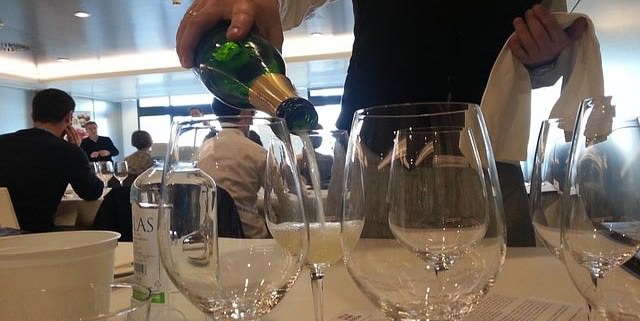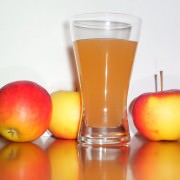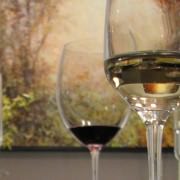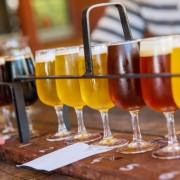What Restaurants Can Learn from Olive Garden to Improve Alcoholic Beverage Sales
The last few days has seen quite a bit of news about Olive Garden and their parent company, Darden. Starboard Value, a hedge fund that is one of the largest shareholders of the public company, has recently put forward a slate of 12 new board prospects to replace the entire board of Darden. Now, Starboard has released a 300 slide deck blasting the inefficiencies they see with Olive Garden and other concepts like Longhorn Steakhouse, while outlining turnaround steps they would take to get the brands on the right track. According to Starboard, Olive Garden is missing out on $56 million in annual earnings by not taking basic steps with their beverage program.
If you are in the hospitality industry, I highly recommend taking a look at Starboard’s analysis and proposal for yourself. But after spending hours reading through their materials, I’m going to highlight several things called out in the report that all restaurants should be focused on to improve the guest experience and bottom line. While there are a lot of problems identified and solutions proposed in the report, I’m going to focus on alcoholic beverages based on our experience at Uncorkd and provide information on how to improve your beverage sales.
Understanding Your Restaurant’s Beverage Sales
The first thing you have to do is have a benchmark of where your sales are at in order to understand how you’re performing. Olive Garden’s alcoholic beverages account for a dismal 8% of total sales. Compared with similar chain restaurant peers, they’re way behind.
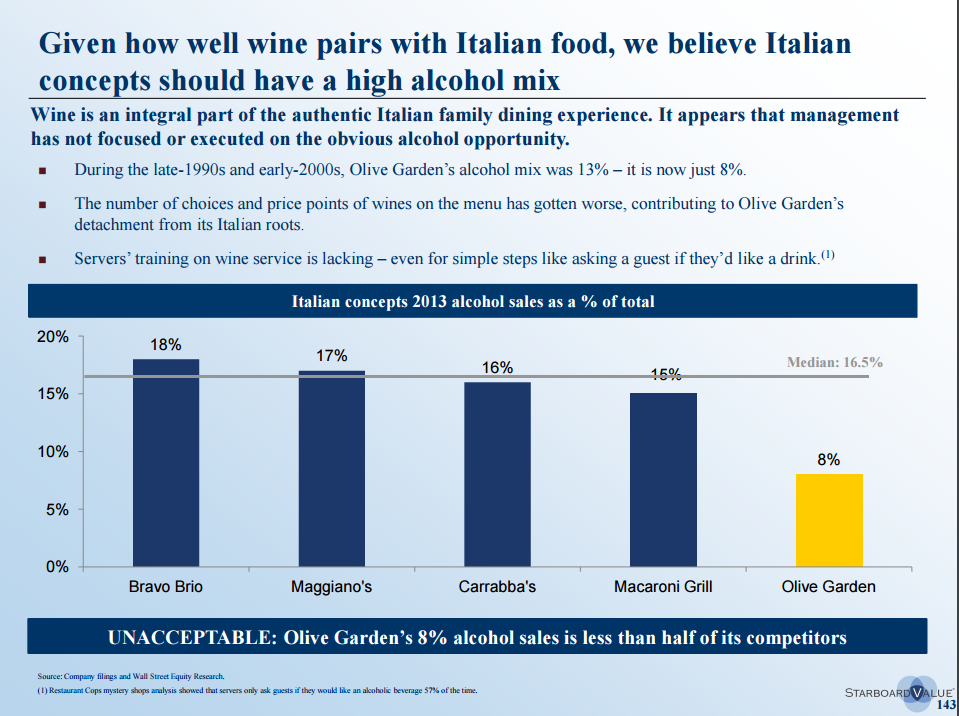
But why are their numbers so low? Admittedly it’s been quite a few years since I’ve been in an Olive Garden, but I can’t even recall if I’ve been handed a wine list there. I surely don’t remember ever seeing one. I don’t recall wait staff ever suggesting wine, offer to make a recommendation or push alcoholic beverages at all. As an Italian restaurant, Olive Garden should have a solid Italian wine list. And if Olive Garden’s customer base isn’t as sophisticated of wine drinkers, they should take the opportunity to educate their customers. Not only will that lead to higher sales, it will show guests that there is a knowledgeable staff, leading to a better experience and repeat visits.
So where should your alcoholic beverage sales be? Well it depends on the style and type of your restaurant. For independent restaurants, alcoholic beverage sales often account for more than 20% of total sales. Many of our Uncorkd customers have alcoholic beverage sales account for 25-30% of their total sales after using our iPad wine and beverage menus. Whatever your sales are, you first have to understand them and analyze why they are what they are.
- How much non-alcoholic drinks are patrons buying?
- What is the sales mix of beer, wine, spirits and cocktails?
- Are customers ordering lowered priced drinks or expensive drinks?
- How is your menu priced? Have you compared your pricing to local competitors?
- Are patrons asking wait staff for something frequently that you don’t have on your menu?
Identify the Problems With Your Beverage Program
Starboard identifies several of the same problems I mentioned above, lack of staff training and a menu with poor choices and price points, with a “detachment from its Italian roots;” a recurring theme throughout the analysis. I find this very interesting, because Darden employees a Master Sommelier, one of only 140 in North America. Their Master Somm is very visible with some of the other Darden brands, especially the specialty restaurants such as Capital Grille and Seasons 52, but doesn’t appear to have a presence with Olive Garden or Longhorn Steakhouse. This makes it likely the problems with Olive Garden are much more systemic from a corporate perspective. I don’t know what’s happening internally, but it could be that employees (even high level ones) aren’t empowered or don’t have authority to affect change, there is a lot of bureaucratic red tape to get things done, or there is a culture of maintaining the status quo.
Whatever their problems are, and let’s be honest all companies have problems like these in one way or another, make sure these are minimized in your restaurant or company. Make sure you’re listening to your staff and making improvements based on their feedback. After all, they are the ones on the front line dealing with your customers. You want to empower your staff to make decisions on their own that will benefit the restaurant, guest and bottom line. But in order to do so, you have to train staff properly, not just once, but on an ongoing basis. A well-trained staff will provide better service, improve the dining experience for guests and most importantly, make your restaurant more money.
Want to improve your alcohol and wine sales? Learn more about how Uncorkd digital wine and beverage menus can enhance your beverage program.
Your Customers Want to Drink Wine and Alcohol
The mix of alcoholic beverage sales will vary from restaurant to restaurant, but YOUR customers want to drink alcohol. No matter where you are located, what style of restaurant or type of cuisine. If you’re a full service restaurant, your customers drink alcoholic beverages. Take a look at this chart from Starboard’s deck:
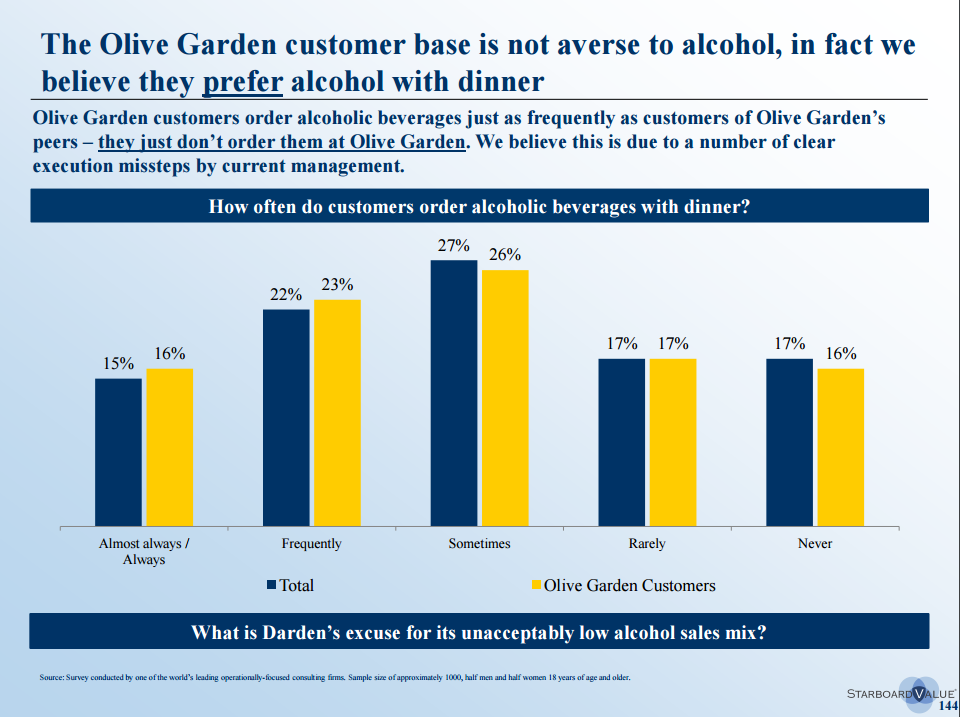
37% of all consumers surveyed (1000 people surveyed from a leading consulting firm) either frequently or always drink alcoholic beverages at dinner. Another 27% sometimes do. So on a Friday or Saturday night, 64% of your covers should be ordering alcoholic beverages. How does your restaurant compare?
Make Your Guests Feel at Ease With Proper Menu Design
Menu design is also critical, whether for a chain like Olive Garden or a fine dining steakhouse. Consumers are intimidated by wine. For decades, wine has been seen as snobby and pretentious. Many consumers can’t pronounce French names or Italian regions or exotic grape varietals. That’s why a wine program has to be inviting and put your customers at ease. Otherwise your guests just won’t order wine, or will point to the cheapest (or second cheapest) bottle on the list. Keep your menu simple, clean and accessible. Or better yet, use a digital wine menu like Uncorkd, that allows you to provide more information and educate guests, without the intimidation.
Likewise, your menu needs to be condensed so that customers can find what they’re looking for. You shouldn’t have a separate menu for beer, another for cocktails and another for your wine list. Not only does this clutter the table and make your staff’s job inefficient, it also makes it difficult for your customers to find what they want. There has been a lot of work done on menu science, such as where do your eyes go when presented with the menu, or how formatting of text affects ordering behavior. If you’re into all that, great, but some of the simplest tips are:
- Make your menus easy to browse and quick to find wine, beer, cocktails and spirits
- Entice your customers with descriptive text (and even pictures)
- Provide suggested pairings or recommendations right on the menu
- Don’t have too much text on each page, it is overwhelming
Here’s What You Can Do to Improve Alcoholic Beverage Sales
Let me get to the point, there is no one time fix and then you’re done. You need to constantly stay on your game to improve your beverage program. Here’s what you need to do.
1. Train your staff, constantly
We’ve hashed this already, but you need to ensure your staff is properly trained on all of your drink options. Your staff should know all about wine, food and wine pairings, and proper wine service. There are many things you can do for training, but the simplest is to have weekly staff trainings and tastings. Have a different supplier come in once a week to provide tastings to your team and talk about their products. This is important for spirits and beer as well. Ensure your staff has actually tasted your cocktails and can make recommendations to a guests liking. Take it even further by using technology to help train your wait staff.
2. Drive innovation with your drink menu
While certain beverage classics will always be a staple of drink menus, tastes change and your menu needs to change as well. There are a of of trends that you may be missing out on and costing you a lot of sales. Craft beer has been growing for years, but yet far too often I go to a full-service restaurant that only carries macro beers like Budweiser or Miller, with maybe an option or two for something else. While some of your clientele may still drink that stuff, more and more consumers, especially younger consumers, drink local or craft beer.
Likewise, whiskey has been growing like crazy as well. Craft distilleries are hot and so are flavored whiskeys, American bourbon and Irish whiskeys. If you haven’t been offering small batch bourbon, you’re missing out on sales. If you’re a casual restaurant or bar and don’t have Fireball, you’re losing money on shots.
If you have multiple locations, empower your local GM or managers to contribute to the menu. While you may have a core list that makes up 80% of the menus across locations, each outlet should have up to 20% of the menu allocated to local choices and selections. Use this for local wines, spirits and beers. A custom cocktail or two that speaks directly to the city or town where it’s located. Be creative and empower local staff to take pride in their offerings.
3. Understand your customers, really.
You may have owned or managed your restaurant for a long time and think you know what your customers like, but as mentioned above, tastes change. Talk to your staff, managers and customers directly. Better yet, analyze the data. Technology provides us many opportunities today to get insight into what was not possible before. Our iPad beverage menus provide analytics to help you better understand what customers are looking at and searching for on your menu. You can see breakdowns of the most popular grape varietals, beer types, item views, and more. Use your point-of-sale data to look not only at what’s selling, but also trends. How are your total alcoholic beverage sales trending? What is the dollar amount spent per cover on alcoholic beverages? Are certain products or types of products selling better than others? Arm yourself with data to understand your customers and deliver a better menu and rotate your selections frequently.
4. Engage Your Customers
Yes, your great service and food should speak for itself, but give customers another reason to come back. Events and wine dinners are a great way to better connect with your customers, offer them something special, and turn them into loyal advocates of your business. This is something so simple that restaurants can do by working with their suppliers who would love the extra exposure. Have limited seating available, invite suppliers to talk about the wine and pairings, and get direct feedback from guests.
- Uncorkd Adds New Vendor Purchasing, Tracking and Reporting Functionality - February 13, 2018
- Uncorkd Adds New Inventory Management Functionality with POS Integration - July 24, 2017
- How Many Red or White Wines Should You Have on Your List - May 3, 2016

